Introduction to Microbial Biofilms
Published online by Cambridge University Press: 24 November 2009
Summary
In any scientific examination that addresses a subject as basic as the mode of growth of bacteria it is prudent to begin by considering the successful prokaryotic communities that clearly predated the development of the eukaryotic cell. During the millions of years in which bacteria constituted the only life form on Earth, we visualize an extremely oligotrophic aquatic environment in which specific ecosystems were impacted by many factors (e.g. heat, acid) hostile to their survival. It is the nature of aquatic systems to flow from one ecosystem to another and we can imagine a primitive stream connecting permissive and non-permissive bacterial habitats in the nascent Earth. Once bacterial cells had evolved, the planktonic (floating) mode of growth would deliver them from one habitat to another until they perished in the first non-permissive locus. The sessile mode of growth as attached bacteria would allow these primitive organisms to colonize a permissive habitat and persist therein. Biofilm formation would allow these sessile organisms to trap and retain scarce organic compounds and to develop a focused attack on complex or refractory nutrients whose processing required time and/or the cooperation of one or more bacterial species. Biofilm formation would also change the microenvironment at the colonized surface in a colonized habitat and render its inhabitants less susceptible to hostile chemical, physical, or even biological (e.g. bacteriophage) factors. Each colonized habitat would become a stable crucible of genetic adaption and physiological cooperativity that would flourish in its own location but would also shed its component organisms as planktonic cells so that, if they survived, they could establish a similar integrated biofilm community in any permissive habitat downstream.
- Type
- Chapter
- Information
- Microbial Biofilms , pp. 1 - 12Publisher: Cambridge University PressPrint publication year: 1995
- 29
- Cited by

